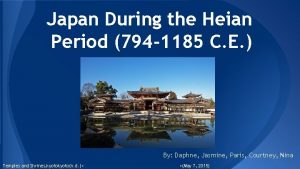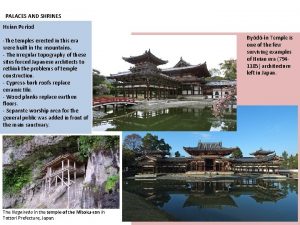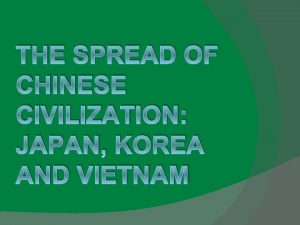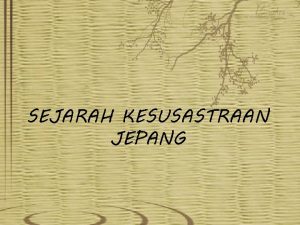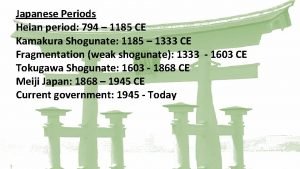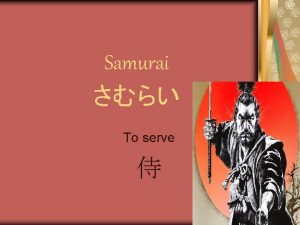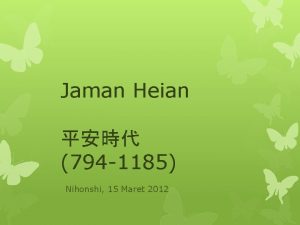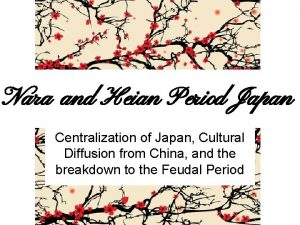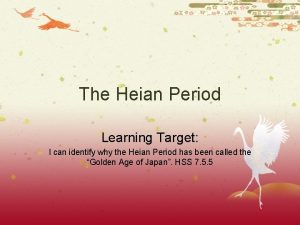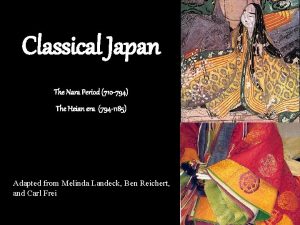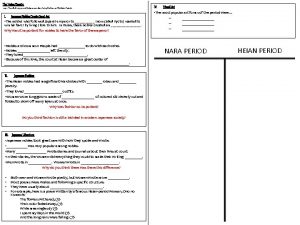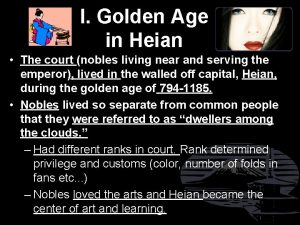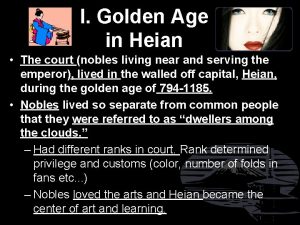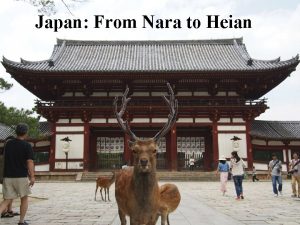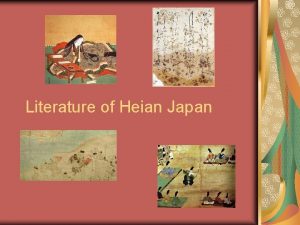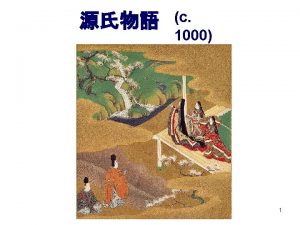LT 4 HEIAN PERIOD In 794 AD the
























- Slides: 24

LT 4 – HEIAN PERIOD

• In 794 AD, the emperor decided to move the capital city of Japan to the city of Heian (Kyoto) • He was followed by a large number of powerful nobles who created an imperial court. • Nobles at court quickly became more interested in their own fortunes and positions than in running the country. • Most devoted their lives to art and culture and knew very little about the world outside the city. They began using the phrase “dwellers amongst the clouds” to describe themselves.

• Men and women at the court competed for the attention of the emperor. • Noble clothing often had 12 layers of expensive silks decorated with gold and silver threads. • Nobles often carried expensive fans which were decorated with poetry or nature images. • A favorite past time of nobles was to take part in poetry writing parties. Nobles could write special poems called Tanka which had a set number of syllables and lines. These poems were based around ideas like love and nature. These poems would then be read out – sometimes with music accompanying them.

• Buildings at Heian were built from light materials like wood and paper. • The goal of builders was to create a natural feel so the wood was often left unpainted. • Palaces and temples were surrounded by gardens which featured trees, flowers, and ponds. • The design of the gardens was based on an ancient Chinese belief called Feng-sui. People believed that good and bad energy could be brought in or expelled based on how the gardens and buildings were arranged.

• Nobles enjoyed going to plays called Noh theater plays combined acting, music, and dance. They would last for several hours so only wealthy people could afford to go to them. • Ordinary people enjoyed entertainments like singing, music, and acrobatics. • Noble women often learned to play a harp-like instrument called a koto. • Ordinary people played bamboo flutes, drums, and a guitar-like instrument called the Shamisen.

THE COURT CULTURE THE HEIAN PERIOD BUILDINGS COURT LIFE

LT 5 – DAIMYO, SAMURAI, & SHOGUNS

• By the 1100 s AD, Japan’s rulers and nobles simply ignored anything outside of the city of Heian. • At the same time, Japan’s powerful landowners (Daimyo) began fighting each other for power and land. • In the fighting, many farms were destroyed causing famines in which millions starved. Many poor people became bandits – robbing others to survive. • To defend themselves, Daimyo began hiring warriors called Samurai – paying them in land or rice. • Samurai would promise to be loyal to their Daimyo. The Daimyo promised to be loyal to the emperor but most simply did whatever they wanted.

• Between the 1150 s and 1190 s several powerful Daimyo fought for control of Japan. • By 1192 the leader of the Minamoto Clan, Yoritomo, had defeated all his rivals. • Yoritomo decided to seize power but he could not get rid of the emperor. Instead he decided to keep the emperor as a figurehead – a person who appears to rule even though real power is held by someone else. • Yoritomo took the title of Shogun, or “general”. • Shoguns would rule Japan for the next 700 years.

• Samurai enjoyed many privileges under the rule of the Shoguns. Ordinary people had to bow and avert their eyes when they passed. If a Samurai though a person had not shown them enough respect they were allowed to execute them. • Samurai were expected to behave with dignity. They were not allowed to go to theater and could not take part in any kind of business. • All Samurai followed a code called Bushido or, “the way of the warrior”. • The first duty of a Samurai was to learn how to fight to protect their Daimyo and their family. Samurai women also learned how to fight to defend their homes while their fathers or husbands were away.

• To improve their discipline, Samurai took part in rituals and activities which required great concentration and patience. • These included tea ceremonies, flower arranging, making miniature Bonsai trees, and meditation. • Honor was very important for all Samurai. If a Samurai lost honor by failing to obey an order or losing a battle he was expected to commit seppuku, or suicide. Doing this would restore his and his families honor.

BREAKDOWN LIVES OF SAMURAI DAIMYO, SAMURAI, & SHOGUNS RULE OF SHOGUNS

LT 6 – CHALLENGES TO THE SHOGUN

• During the 1200 s AD, a people called the Mongols managed to conquer most of China and Korea. • Mongol rulers began to demand that Japan pay it tribute in the form of gold, silver, and food. However the Japanese refused. • In 1274 the Mongols invaded Japan. The Japanese were not well prepared to fight the Mongols. Samurai were used to fighting one-on-one duels while the Mongols fought with hundreds of soldiers armed with spears, bows and arrows, and gunpowder weapons. • The Japanese were close to defeat when a large typhoon began to develop – destroying or damaging many Mongol ships. The Samurai then used small boats to board the surviving ships and kill their crews.

• The Japanese were worried that the Mongols might return so they spent huge amounts of money building forts and walls on the coast. • The Mongols sent messengers to Japan to demand more tribute but the Shogun had them executed. • In the spring of 1291 the Mongols sent two huge fleets towards Japan from China and Korea. On the ships were over 150, 000 soldiers. • The Mongols tried to break through the Japanese defenses but failed. Another typhoon began to develop which sunk most of the Mongol fleet and forced the survivors to retreat. The Japanese called this storm the “Kamikaze” or “Divine Wind” and believed it had been sent by the gods to save Japan.

• After the war, many Daimyo thought the Shogun was taking too much credit for the victory. The cost of the defenses also meant that the Shogun couldn’t afford to reward them. • During the 1330 s a new emperor tried to take power back from the Shogun. During the war between them, many Daimyo took advantage of the chaos to break free of the control of both. • By the 1400 s, Japan was divided into hundreds of small states – each ruled by a different Daimyo. • Daimyo constantly tried to conquer or assassinate their rivals using hired spies called ninja. Families began to tear apart as sons tried to kill their fathers and brother fought against brother.

• During the 1550 s a powerful Daimyo called Oda Nobunaga began using guns which he bought from the Portuguese to defeat his rivals. • Nobunaga promoted soldiers based on their skills and abilities rather than simply their birth. He was about to take control of Japan when he was killed by one of his own officers. • Nobunaga was succeeded by a general called Toyotomi Hideyoshi. He tried to restore peace and order by banning ordinary people from owning swords. People were also banned from changing the social class they were born into. • When Hideyoshi died he was succeeded by another general, Tokugawa Ieyasu. Members of his family would go on to rule Japan for another 250 years.

NEW LEADERS CHALLENGES TO THE SHOGUN BREAKDOWN OF ORDER THE MONGOLS

LT 7 – THE TOKUGAWA SHOGUNATE

• Tokugawa Ieyasu decided to move the capital city to Edo (Tokyo) where he had most of his land support. • Daimyo who were believed to be disloyal had their lands taken away and given to Ieyasu’s supporters. • Each Daimyo was now allowed only one Han (province) on which they could only build one castle. • Daimyo had to spend one year in Edo followed by one year back in their province. While they were away, their wives and children had to stay in Edo. • Travel was controlled with checkpoints on all major roads where papers would be examined. • Shoguns also decided marriages between different Daimyo families.

• The biggest challenge to the Tokugawa Shogunate came from the religion of Christianity which was brought to Japan by the Spanish and Portuguese. • By the early 1600 s a large number of people, even some Daimyo, had converted to the new religion. • Christianity was a threat to traditional beliefs of Japan, especially that the emperor was a living god. Shoguns also worried that the Spanish and Portuguese might try to take over their land. • During the early 1600 s, large numbers of Christians were expelled from the country. In 1637 a Christian rebellion was defeated after which 40, 000 men, women, and children were killed. • The last of the Spanish and Portuguese were then thrown out of Japan.

• To avoid foreign influences, the Shoguns adopted a policy called sakoku or “locked country”. • Japanese people were banned from leaving the country. Those who were already abroad were not allowed back. • Only small fishing boats were now allowed. Any large ships were destroyed. • The only Europeans allowed to trade in Japan were the Dutch. Even then, they were limited to staying on a small island in the middle of Nagasaki harbor. • Chinese and Korean traders were still allowed but they could only enter Japan through a few special ports. • Any person landing on the Japanese coast, even by accident, was executed.

• Tokugawa society was strictly organized. By law people had to follow the profession of their parents. Anyone found breaking any law would be harshly punished along with other members of their family. • In the upper class were the emperor and nobles. They devoted their lives to art and culture and played little role in government. • The ruling class was made up of the Shogun, Daimyo, and Samurai. The Samurai were ordered to give up any lands they owned. Instead they were simply paid a salary every year in return for their service. • At the top of the lower class were farmers followed by craftsmen. At the bottom of the lower class were merchants and traders. Towns and cities were organized so that these people lived in special neighborhoods. • At the very bottom were the Eta (“filthy”) and Hinin (“Non-Human”). These people did jobs like butchering animals, making leather, preparing dead bodies, entertaining, cleaning, and begging. They had no rights and were forced to live in special villages and wear special clothes. A Samurai could kill an Eta or Hinin for no reason.

GOVERNMENT SOCIETY THE TOKUGAWA SHOGUNATE ISOLATIONSIM CHRISTIANITY
 Daphne chu
Daphne chu Kalio jododas
Kalio jododas Worx wg 794 e
Worx wg 794 e Spread of china's literature to heian japan and korea
Spread of china's literature to heian japan and korea Kesusastraan zaman joodai
Kesusastraan zaman joodai Heian court hierarchy
Heian court hierarchy The golden age chapter 20
The golden age chapter 20 Grade 7 background
Grade 7 background Art and culture in heian
Art and culture in heian Critical/sensitive periods
Critical/sensitive periods Stability period vs measurement period
Stability period vs measurement period Absolute refractory period and relative refractory period
Absolute refractory period and relative refractory period Classical music has less complicated texture
Classical music has less complicated texture Critical period vs sensitive period
Critical period vs sensitive period Trustee period and royal period
Trustee period and royal period Absolute refractory period and relative refractory period
Absolute refractory period and relative refractory period 26 protons period 4 transition element
26 protons period 4 transition element Written records in history
Written records in history Critical period vs sensitive period
Critical period vs sensitive period The seeds of activism resulted in the what declaration ?
The seeds of activism resulted in the what declaration ? Cynthia lightfoot
Cynthia lightfoot Thế nào là mạng điện lắp đặt kiểu nổi
Thế nào là mạng điện lắp đặt kiểu nổi Hát kết hợp bộ gõ cơ thể
Hát kết hợp bộ gõ cơ thể Khi nào hổ con có thể sống độc lập
Khi nào hổ con có thể sống độc lập Dot
Dot
